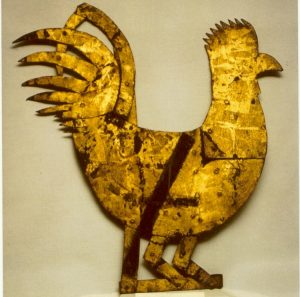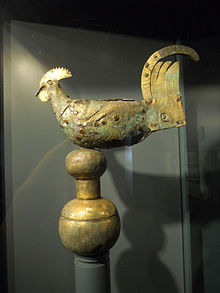
In 1772 this weather vane or “weathercock” was surmounted on the tower of the stone Dutch Reformed Church which would one day become the Old Stone Fort Museum in present day Schoharie, NY.
The weathercock remained in place atop the building until approximately 1830, surviving harsh weather, the transformation of the church into a Revolutionary War fort in 1777 and an attack by loyalist forces in 1780. The weathercock, which is on display in the Old Stone Fort Museum today, has become the symbol of the Schoharie County Historical Society and has a religious symbolism stretching back to the 9th Century and beyond.
The first known textual reference to weather vanes comes from China in about 139 BC. It wasn’t until the 3rd Century (201-300 AD) that weather vanes first began being shaped into birds.

It was Pope Gregory I, in approximately 600 AD, who made the first known religious connection to weather vanes in the shape of a rooster. Pope Gregory I theorized they were the “most suitable emblem of Christianity,” being “the emblem of St. Peter” and referenced Luke 22:34 in which Jesus predicts that Peter will deny him three time before the rooster crows.
As a result, weather vanes in the shape of roosters or “weathercocks” began to be used on church steeples across Europe and in the 9th Century (801-900 AD) Pope Nicholas made an official religious decree that the figure be placed on all church steeples.
The tradition of placing of a weathercock atop churches was maintained in Europe for centuries and followed settlers as they began to cross the Atlantic and build communities in the new world. For many, the cock stood for the pastor who led and watched over the parish and for the position of the church in the community. Also, as the bird of light, the cock is the symbol of Christ and of the Resurrection.
The oldest surviving weather vane in the shape of a rooster today is the Gallo di Ramperto, made in 820 AD and now preserved at the Museo di Santa Giulia in Brescia, Lombardy.